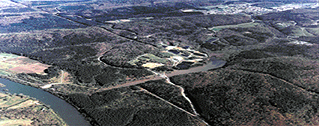White Oak Creek Radionuclide Releases

Public Health Assessment
In 1942, the U.S. government established the Oak Ridge Reservation (ORR) in Anderson and Roane Counties in Tennessee. The reservation was part of the Manhattan Project, a government program to research, develop, and produce radioactive materials for nuclear weapons. One of the facilities built at that time was the X-10 site, created to process plutonium. After the end of World War II, the role of the ORR under the Atomic Energy Commission, which subsequently became part of the Department of Energy (DOE), broadened to include a variety of nuclear research and production projects vital to national security.
Beginning in 1943, some contamination from the ORR entered White Oak Creek (located on the reservation) and flowed off the reservation into the Clinch River and Watts Bar Reservoir. Most of the radioactive contamination in the creek came from the X-10 site (known in the past as Clinton Laboratories and now called the Oak Ridge National Laboratory, or ORNL). People living along and using the Clinch River and the Lower Watts Bar Reservoir want to know if their health could be affected by the radionuclide releases. The Agency for Toxic Substances and Disease Registry (ATSDR) conducted a public health assessment to evaluate whether these radiological releases could be harmful for people who use, or who live near, the Clinch River and the Lower Watts Bar Reservoir.
ATSDR's scientists concluded that some residents living along or visiting the Clinch River and the Lower Watts Bar Reservoir were exposed to radionuclides released from the X-10 site via White Oak Creek. The greatest exposure occurred in the 1950s, and resulted from frequently eating fish caught near Jones Island, close to the mouth of White Oak Creek. The radiation dose from eating fish from the Jones Island area was well below levels associated with a health hazard. Radiation doses were much lower for the other exposure pathways evaluated (drinking water and milk, walking on sediment, and eating meat) and for individuals who caught their fish further downstream. Therefore, ATSDR does not expect adverse health effects to occur from past, current, and future exposure to the surface water, sediment, drinking water, and fish in the Clinch River and Lower Watts Bar Reservoir, and to turtles and geese in the Clinch River.
Contact Us:
- Agency for Toxic Substances and Disease Registry
4770 Buford Hwy NE
Atlanta, GA 30341-3717 USA - 800-CDC-INFO
(800-232-4636)
TTY: (888) 232-6348
Email CDC-INFO - New Hours of Operation
8am-8pm ET/Monday-Friday
Closed Holidays


